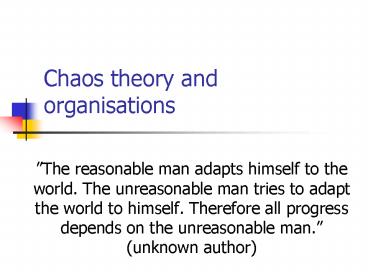Chaos theory and organisations - PowerPoint PPT Presentation
1 / 20
Title:
Chaos theory and organisations
Description:
Chaos theory is about dialectic relations. Change. Nonlinear relations ... Chaos theory can tamper with the dialectics of nature by interfering in the ... – PowerPoint PPT presentation
Number of Views:583
Avg rating:3.0/5.0
Title: Chaos theory and organisations
1
Chaos theory and organisations
- The reasonable man adapts himself to the world.
The unreasonable man tries to adapt the world to
himself. Therefore all progress depends on the
unreasonable man. (unknown author)
2
Many names for the same
- temporay society (Bennis, 1967)
- age of discontinuity (Drucker, 1969)
- age of unreason and beyond certainty (Handy,
1997, 1998) - a general theory of economic discontinuities
(Rosser, 2000)
3
Why is chaos theory important?
- Organisations operate in turbulant and dynamic
environments. - This means uncertainty, unease and feelings of
powerlessness with people in and around
organisations. - This is unfortunate as it often is on the
outskirts of chaos that creativity flourishes.
4
Why is chaos theory important?
- Understanding chaos theory is important because
of its significant implications for world systems
design, organization design and administrative
behaviour, and public policy analysis and
implementation. (Farazmand 2003341) - Regrettably not much has been written about chaos
theory and public administration and
organisations.
5
Chaos theory is about dialectic relations
- Change
- Nonlinear relations
- Turbulence
- Chaos
- Collaps of systems
- Imbalance
- Sharing
- Segments
- The human being
- Continuity
- Linear relations
- Stability
- Order
- Balance
- Transformation
- Unities
- System
- Nature
6
There is not one final definition of chaos theory
- Chaos theory tries to understand the relation
between chaos and order. In this way, it is
possible to follow both directions, from order to
chaos, or from chaos to achieve order. (Dolan et
al. 200324)
7
There is not one final definition of chaos theory
- The notion of chaos denotes chrisis and
disorder, a state of non-equilibrium,
instability, turbulence, rapid changes that
scramble plans and cause unpredictability, with
consequenses of anxiety, fear of unknown, and
triggering and tripling effects of destruction
and systems breakdown. (Dolan et al. 200324)
8
Catastrophies and chaos
- Microcosmic level chaos, short to middle long
term - Macrocosmic level catastrophies, long term,
paradigmatic in essence, almost like Kuhn
9
Systems theory and chaos theory
- Systems theory is concerned with stability and
equilibrium whereas chaos and transformation
theories are characterized by chaotic changes
that lead to order and vice versa. (Farazmand
2003351)
10
Punctuated equilibrium and the shaking and
cracking state
- Designed chaos
- The purpose is to change something from an
unwanted situation to a wanted situation for
example by changing values in an organisation
from minus to plus - Natural evolution chaos
- Surroundings change in a dynamic process both
including and excluding humans
11
Implications for organisational theory (Farazmand
2003362-363)
- Like other living systems, open organizations
possess self-corrective mechanisms or
negentropies that fight forces of decay and
stagnation and revitalize the system. This is the
dynamics of all open, living systems.
12
Implications for organisational theory
- From classical closed systems of the early
twentieth-century bureau-cracy characterized by
stability, order, and avoidance of change
- To new organizations characterized by
instability, chaotic changes, system breakdowns
with bifurcations into new orders, and negative
feedbacks and non-equilibrium features as
positive indredients producing dynamism
13
Implications for organisational theory
- Organizations and their leadership must induce
periodic changes of a chaotic nature to shake up
and crack the stable system for renewal and
revitalization.
14
Implicationess for organisational theory
- Chaos and transformation theories imply the
learning organizational concept necessary for
change, adaptation, and adjustments to respond to
the external environmental changes and
paradigmatic shifts or strands. - Organizations that learn, adjust, and adapt to
the external pressures causing systems breakdown
and bifurcations can survive and evolve, and
their evolution comes through internal learning
and transformation.
15
Implicationess for organisational theory
- Nonlinear relationships, chance, and randomness
may characterize much of modern organizational
systems, and many organizational problems must be
managed or solved by nonlinear thinking. This is
what Karl Weick called natural selection toward
evolution, with the fittest to survive and those
selected out to die.
16
Implicationess for organisational theory
- Chaos theory may explain the current chaotic
changes and trends so pervasive in the management
of public, private, and nonprofit organizations
worldwidelike downsizing, sweeping
privatization, environmental deregulation, and
expansion of the corporate-based, private sector
17
Implicationess for organisational theory
- The transformation of personal assumptions into
learning assumptions would make organizational
leaders able to adapt faster to the turbulent
organizational environment and to lead
organizations through learning and managing in
times of chaotic changes. - Chaos and transformation theories can be seen as
an anticipatory management system based on
perpetual learning principle that makes complex
organizations manageble and dynamic.
18
A word of caution! (Farazmand 2003364-366)
- Chaos theory can tamper with the dialectics of
nature by interfering in the natural evolutionary
processes. - Chaos theory can be a powerful tool of
manipulation and control in the hands of few
powerful elites for economic, social, political,
and military reasons.
19
A word of caution!
- Unpredictability of outcomes of chaotic states or
systems pose further dangerous, and potentially
fatal, threats to individuals, groups, cultures,
and peoples around the globe.
20
A word of caution!
- If chaotic events or processes will eventually
lead to order, or order to chaos, how do we know
that injecting chaotic forces into prevaliling
stable systems will lead to eventual order,
especially desired order? Whose order is the
desiered order?

